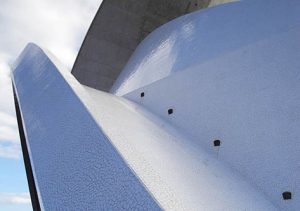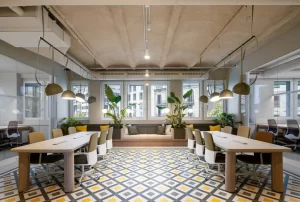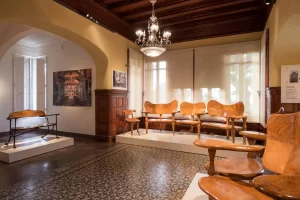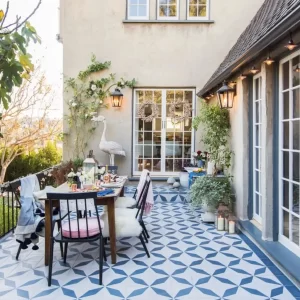The trencadís is one of the best known construction techniques of the modernism Catalan. In this article we explain what it consists of, examples of buildings that use it and where to buy the material.
What is the trencadís technique?
The trencadís concept is a translation from Catalan. The more correct Castilian meaning would be brittleand refers to a type of hydraulic mosaic which is done with pieces of tiles that have been cemented. The result is a floor, wall, façade or sculpture with a different and characteristic effect.
This construction technique was used mainly for ornamental purposes and is part of the catalan modernist architecture. However, it should also be pointed out that in the Valencian Community it is possible to find several buildings with this technique.
Buildings where you can find trencadís
The trencadís is a invention of the great Architect Antoni Gaudí, although it is true that it had been experimented with before
It was first used between 1883 y 1887. It is important to note that it has subsequently been adopted by other architects and in other territories. Therefore, today there are civil, religious and other buildings, not only modernist, that include it.
In any case, there is agreement that it is a technique that is eminently Mediterranean. The main chronological difference is that in the early days, the remains of hydraulic ceramics disposable items such as, for example, fragments of plates. Today, however, this technique is much more refined and new technologies are used to achieve more attractive visual effects.
-
Güell Estate
The Güell Estate and Parklocated in the Pedralbes district of Barcelona, was one of Gaudí's first works. The pavilions were built between the years of 1883 y 1887. This technique can be observed in the pavilions of the towers of the pavilions with clarity. It was the first time that this philosophy was employed with a certain stylistic coherence.
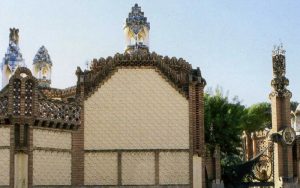
-
La Pedrera
This is one of Gaudí's most famous buildings, although it was not without controversy. The name Pedrera was, in its beginnings, a nickname, and it was built between 1906 y 1912. Trencadis was used for the towers of this house, located in the Barcelona's Eixample.
Today they are preserved in perfect condition and crown the building. We see, then, that there is a chronological coherence in Gaudí's use of this technique in various buildings and periods.
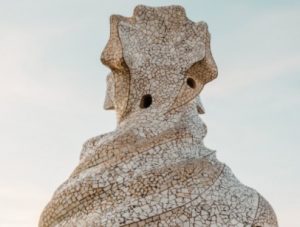
-
Park Güell
The Park Güell is one of Barcelona's main tourist attractions, although it was originally conceived as an urban development, built between 1900 y 1914. The iconic dragon is coated with trencadísas well as in the hypostyle hall or in the banks which provide a view of the city. It is probably one of Gaudí's works in which we find this constructive element most often.
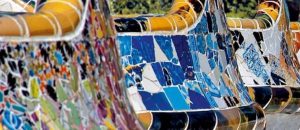
-
City of Arts and Sciences of Valencia
Santiago Calatrava is the architect of today who has done the most to introduce the concept of the trencadís in the works.
Although it has its own concept, in many respects it is inspired by the architect A. Gaudí and other modernist architects. Thus the monumental building of the City of Arts and Sciences of Valencia has several such elements.
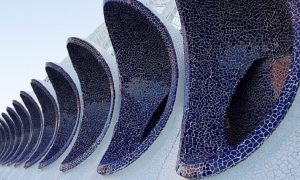
-
Adán Martín Auditorium of Tenerife
The Adán Martín Auditorium of Tenerife is another of Santiago Calatrava's masterpieces. It was built between 1997 and 2003 and we can see fragments of it. bankrupts in the external façade. Its location and presence are exponents of a clear post-modern concept. The idea is to give the building a lively image, which can be achieved thanks to the white pieces of trencadís. This is one of the exponents of postmodernist architecture.
Mosaics Torra as a supplier of hydraulic mosaics
At Mosaics Torra we manufacture all types of cement tiles and mosaicsinspired by the works of Antoni GaudíFor example, the trencadís hydraulic mosaic is inspired by this philosophy. With the difference that, if you wish, you can put it in the interiors of your home.
Our good work as manufacturers, marketers y restorers of public buildings precedes us. In the 1990s, the manufacture of cement tiles became fashionable again, so that modernist construction techniques were revalued. We have been and still are a reference in the sector, so we have contributed to restoring Park Güellamong other actions. We have both public and private clients.
For all of these reasons, if you are looking for a supplier of cement tiles and mosaics confidence in you, we encourage you to contact us contacts. You will find what you are looking for and you will be able to give a new touch to your stay.


